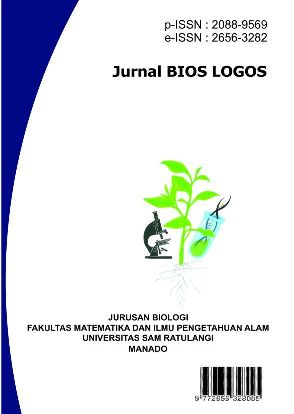Skrining Fitokimia dan Uji Antibakteri Nanopartikel Perak Ekstrak Daun Pepaya (Carica papaya L) terhadap Bakteri Staphylococcus epidermidis dan Salmonella typhi
DOI:
https://doi.org/10.35799/jbl.v13i3.49813Keywords:
antibacterial, papaya leaf, Silver NanoparticlesAbstract
Infections caused by bacteria are still common in developing countries, among them Staphylococcus epidermidis and Salmonella typhi. In Indonesia, papaya leaves (Carica papaya L.) are widely used as traditional medicine because they contain compounds that are antibacterial. The combination of silver nanoparticles with papaya leaves has the potential to increase antibacterial effectiveness. The purpose of this study was to determine the effectiveness of papaya leaf extract silver nanoparticles in inhibiting Staphylococcus epidermidis and Salmonella typhi bacteria. This research method is a true experiment with a post-test only design with a control group. The results showed that papaya leaf metabolites consisted of flavonoids, steroids, and tannins, while the total levels contained in flavonoids 791.209%, and tannins 11.138%. The diameter of the inhibition zone concentrations of 100, 150, 200, and 250 ppm proved that papaya leaf extract combined with silver nanoparticles had good antibacterial active compounds but was more powerful in killing Staphylococcus epidermidis bacteria than Salmonella typhi bacteria.
References
Agustina, S., Ruslan and Wiraningtyas, A. (2016) Skrining Fitokimia Tanaman Obat Di Kabupaten Bima, Cakra Kimia (Indonesian E-Journal Of Applied Chemistry), 4(1), pp. 71–76.
Ahmed, B. (2007) Chemistry of Natural Produvts. Edited by Jamia Hamdard. New Delhi: Departemen of Pharmaceutical Chemistry of Science.
Fadlilah, A. L. N. and , Widya Hary Cahyati, R. W. (2017) Uji daya proteksi ekstrak daun pepaya (Carica papaya L) dalam sediaan lotion denga basis PEG 400 sebagai repellent terhadap Aedes aegypti, Jurnal Care, 5(3), pp. 393–402.
Francis, E. and Jose, V. (2016) The Antibacterial Effect of Carica papaya L. Extracts and Their Synergistic Effect with Antibiotic and Non-antibiotic Drugs, British Microbiology Research Journal, 16(4), pp. 1–11.doi: 10.9734/bmrj/2016/28042.
Madduluri, S., Babu Rao, K. and Sitaram, B. (2013) In vitro evaluation of antibacterial activity of five indigenous plants extract against five bacterial pathogens of human, International Journal of Pharmacy and Pharmaceutical Sciences, 5(SUPPL.4), pp. 679–684.
Marjorie Murphy Cowan (1999) Plant Products As Antimicrobial Agents, Clinical Microbiology Review, 12(4), pp. 564–582. doi: 10.3390/curroncol14040004.
Martien, R. et al. (2012) Perkembangan Teknologi Nanopartikel Sebagai Sistem Pengahantaran Obat, Majalah Farmaseutik, 8(1), pp. 133–144.
Nilavukkarasi, M., Vijayakumar, S. and Prathip Kumar, S. (2020) Biological synthesis and characterization of silver nanoparticles with Capparis zeylanica L. Materials Science for Energy Technologies, 3, pp. 371–376. doi: 10.1016/j.mset.2020.02.008.
Nitisapto M, S. A. S. (2005) Evaluasi Kesesuaian Lahan Untuk Pengembangan Jahe pada Beberapa Daerah di Jawa Tengah dan Jawa Timur, Jurnal ilmu tanah dan lingkungan, 5(2), pp. 15–19.
Rahmatika, D. and Oktaria, S. (2021) The Differences In The Antibacterial Power Test Of Ginger (Officinale Var . Rubrum) And Onion (Allium Sativum) On The Growth Of Bacteri, Jurnal Kedokteran Ibnu Nafis, 10(1), pp. 1–8. Available at: https://ojsfkuisu.com/index.php/ibnunafis Jurnal.
Rahmawati, F. and Bintari, S. H. (2014) Studi Aktivitas Antibakteri Sari Daun Binahong (Anredera cordifolia) Terhadap Pertumbuhan Bacillus cereus Dan Salmonella enteritidis, Life Science, 3(2), pp. 103–111.
Rai, M., Yadav, A. and Gade, A. (2009) Silver nanoparticles as a new generation of antimicrobials, Biotechnology Advances, 27(1), pp. 76–83. doi: 10.1016/j.biotechadv.2008.09.002.
Reza Alzanado, Mashuri Yusuf, T. (2022) Analisis Kadar Flavonoid Total Ekstrak Etanol Daun Daun Bunga Pepaya (Carica Papaya L.) Secara Spektrofotometri Uv-Vis, Farmasi Malahayari, 5(1), pp. 108–120. Available at: http://librepo.stikesnas.ac.id/40/.
Tandigorang N (2015) ‘Demam tifoid’, (Fakultas Kedokteran Universitas Gajah Mada).
Taufiq, S., Yuniarni, U. and Hazar, S. (2015) ‘Uji Aktivitas Ekstrak Pepaya (Carica papaya L.) Terhadap Escherichia coli dan Salmonella typhi’, Journal of Chemical Information and Modeling, 110(9), pp. 1689–1699.
Tuntun, M. (2016) ‘Uji Efektivitas Ekstrak Daun Pepaya (Carica papaya L.) terhadap Pertumbuhan Bakteri Escherichia coli dan Staphylococcus aureus, Jurnal Kesehatan, 7(3), p. 497. doi: 10.26630/jk.v7i3.235.
Verma, S., Kumar, R. V. and Singh, S. (2017) Medicinal and Pharmacological parts of carica papaya: a review, Indian Journal of Drugs, 5(3), pp. 88–93.
Wahyudi, T., Sugiyana, D. and Helmy, Q. (2011) ‘Sintesis Nanopartikel Perak Dan Uji Aktivitasnya’, Balai Besar Tekstil, 26(1), pp. 55–60.
Zulkoni, A. (2011) Parasitologi. Yogyakarta: Nuha Medika.
Downloads
Published
How to Cite
Issue
Section
License
Copyright (c) 2023 Ni Made Suarjo Putri, Dwi Sutiningsih, Mochamad Hadi

This work is licensed under a Creative Commons Attribution 4.0 International License.










